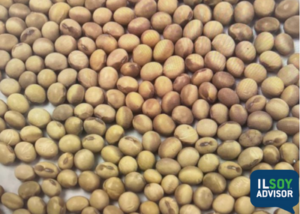UPDATE: On July 14, 2023, the USDA Agricultural Marketing Service (AMS) published a final rule to the Federal Register revising the U.S. Standards for Soybeans and officially removed soybeans of other colors (SBOC) as an official grade-determining factor. To read about this update, click here.
When grading soybeans, some off-color seed coats can occur due to various issues such as viral diseases, weather, and ground damage. The following USDA resource, Soybean of other color (SBOC) Grading Guidance (usda.gov), is a guide to grading of Soybeans of Other Color (SBOC). This issue is nothing new, but a much higher percentage of Enlist E3 soybeans (tolerant to 2,4-D choline, glyphosate, and glufosinate) are being sold within the marketplace today as another tool to attack resistance weeds. We have started to hear more about “natural seed discoloration” caused by:
- genetics (certain varieties)
- the environment (temperature, soil type, planting date, moisture)
- other factors
We have been seeing this natural off coloring described as “brown banding,” “brown shadows,” or “saddling” on the seed coats of Enlist E3 soybeans for the past several years. I think it is important to remember the following facts:
- The color variation is a combination of natural compounds (iron and isoflavone) and can only be seen on the Enlist E3 soybean seed coat.
- The color variation does not impact plant appearance, seed germination, emergence.
- From a practical standpoint, seed coat color is unlikely to have any effect on the quality of soybean meal or oil produced (Seth Naeve/Shawn Conley).
- Not all Enlist E3 soybean varieties will consist of an off-color seed coat.
- Farmers may see the color variation in some Enlist E3 soybean varieties, but it may not occur consistently in every field each year.
- More information can be found here: Enlist-E3-Soybean-Quick-Reference-Guide.pdf

Why does it matter? When grading soybeans, seed coat color is just one of many factors used by the U.S. Federal Grain Inspection Service (FGIS) to grade soybeans:
- Up to 1% of soybeans of other colors are allowed and this grade is a U.S. No. 1.
- When the soybeans of other colors increase to 2%, the grade is a U.S. No. 2 and 5% for U.S. No. 3 grade yellow soybeans
- “By May of 2022, around 32% of (FGIS) soybean certificates included soybeans of other color that were greater than 1%. So, nearly 1/3 of soybean samples did not make the U.S. #1 yellow soybeans due to off-colored soybeans. In previous years, fewer than 1% of soybean certificates failed to make US #1 due to soybeans of other color (Seth Naeve/Shawn Conley).” More information here: (SBOC)…..One MORE thing to think about this fall? – Cool Bean
- Currently, U.S. soybean processors will be unlikely to implement dockage on soybeans containing over 1% soybeans of other color.
- However, if these soybeans shipments are for exported food use, the presence of discolored seeds may lead to rejections at either the origin or destination.
- The other key criteria taken into consideration when it comes to soybean grading is test weight, moisture, heat damage, total damaged seeds, foreign material, splits, as well as protein and oil. More information can be found here: Soybeans of Other Colors Resource Page | Agricultural Marketing Service (usda.gov).
In conclusion, Eric Woodie of the Illinois Soybean Association has offered the following points:
- It is important to remember, from ISA’s perspective, this remains a contracting matter between exporters and destination buyers, rather than a quality issue.
- Our industry is extremely nimble and can manage the situation. The U.S. remains very well equipped to continue supplying soybeans to the world.
UPDATE as of 11/9/22 – The USDA has recently received many requests to remove SBOC as a grade-determining factor to describe soybean quality. They have responded to these requests by implementing a notice and comment rule making, which is required by the USGSA, for the public to comment on whether SBOC should be considered an informal factor that DOES NOT IMPACT SOYBEAN GRADE DETERMINATIONS. For additional information, you can go to AMS Announces Plans to Amend the U.S. Standards for Soybeans | Agricultural Marketing Service (usda.gov)
If you have had issues with SBOC, please contact Stephanie Porter, ISA Outreach Agronomist, at stephanie.porter@ilsoy.org or 309-660-5302.
Other Resources:




 and then
and then